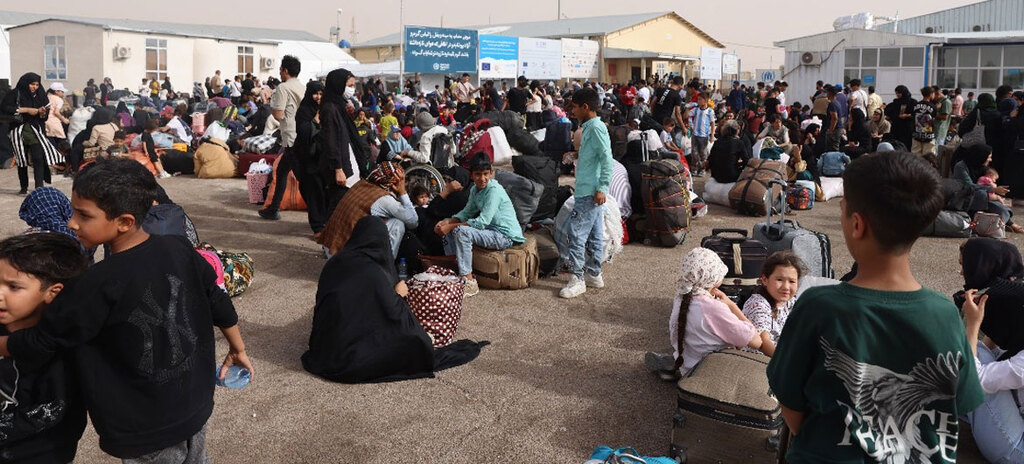Written by Hussain Ali Haidari

In recent days, a significant wave of migrant expulsions from Iran has begun. News sources report that hundreds of thousands of Afghan migrants have either been expelled or have returned from Iran. According to some these reports, 27,000 migrants were expelled from Iran in just one day. Furthermore, the High Commission for Addressing Migrant Issues announced the return of over 600,000 individuals from Iran in the past month alone. The International Organization for Migration (IOM) also stated that approximately 900,000 Afghans have returned from Iran to Afghanistan since January.
The forced expulsion of migrants from Iran has drawn strong condemnation from global communities and both national and international organizations. Roza Otunbayeva, the UN Secretary-General’s Special Representative for Afghanistan and head of UNAMA, has warned about the severe consequences of the widespread return of Afghan migrants. She has called for immediate action from the international community to address the situation of those returning.
The Taliban have also reacted to the forced expulsions, calling for better treatment of the migrants. The Taliban’s Chief Minister urged Iranian authorities to “refrain from violating the rights of these migrants” to prevent “resentment and hatred between the two nations.”
The former President of Afghanistan has also stated: “Our request and expectation from host countries is that, considering the existing problems in various areas, especially economic hardship and the closure of schools and universities to girls, they reconsider their decision for the forced and widespread expulsion of Afghan migrants.”
Now, a fundamental question arises: What are the consequences of expelling and returning migrants from Iran to Afghanistan?
The expulsion or return of migrants from Iran to Afghanistan will present the country with numerous challenges. Among these, several categories can be highlighted:
1. Humanitarian Crisis
Some reports indicate that 13 Afghan migrants have died at the Islam Qala border crossing due to extreme heat. According to these reports, the Deputy Special Representative of the UN Secretary-General for Afghanistan and Humanitarian Coordinator stated, “The window to prevent a full-blown humanitarian catastrophe is rapidly closing.” Eyewitnesses and reporters describe the situation of migrants at the Islam Qala and Dogharun borders as extremely dire.
Ahmad Soheil, a resident of Kabul who recently returned from Iran, says thousands of newly returned migrants are stranded at the Islam Qala border. They’re enduring temperatures of around 50 degrees Celsius (122 Fahrenheit) with no aid reaching them. He also adds, “The behavior of the Iranian police and law enforcement forces towards the migrants is extremely insulting and dehumanizing. Migrants are being beaten and transported to the border in containers in this scorching heat. Their money is not being returned by employers and landlords.”
Qudoos Khan is an elderly man and head of a family who was expelled from Karaj City in Iran, leaving his wife and two young children behind. He recounts seeing a family expelled from Iran whose young daughter, who was in school, was left without a guardian.
Sadra, who recently arrived in Kabul from Tehran with her husband and three young children, says: “We had been in Iran for about ten years. My children were studying in grades 4, 7, and 11. I also have heart disease. When I went to the Alien Sponsorship and Residency Office, they told me I had until July 1st to leave Iran. I told them: ‘I have 200 million [Iranian toman] in rent deposit with our landlord.’ They said: ‘You solve the issue yourself.’ Now we are in a bad situation. We can’t find work. Currently, we are staying at a friend’s house.”
2. Economic Consequences
A significant number of Afghan migrants in Iran had moved there to support their families. By working in difficult and demanding jobs, they would earn wages and send them back home, enabling their families to get by. With their expulsion from Iran, these families have lost their source of income. Furthermore, the lack of employment opportunities in Afghanistan not only leads to economic ruin for returning migrants but also potentially exacerbates poverty within the broader society.
Ahmad Rashid, who recently arrived in Kabul, has a family of seven to support. He states: “I was working at a Marble factory in Isfahan, Iran. One night, Law Enforcement Force of the Islamic Republic of Iran raided our home, arrested all of us, and loaded us onto vehicles.” Rashid adds: “The Iranian police didn’t give us any chance to gather our belongings or collect our wages from our employer. Now I’m looking for a loan from my friends. No one here is even lending money. I’m at a loss for what to do.”
3. Social Consequences
The uncontrolled influx of migrants from Iran will not only lead to increased poverty, unemployment, and economic collapse, but it will also double existing problems with housing and services. Currently, the prices of basic goods and homes have surged. The scarcity of land for housing and high rental costs, coupled with restrictions on construction imposed by the Taliban, have made it even more difficult for returning migrants to secure a place to live.
Although the Taliban regime claims to be building townships for migrants, reports suggest that these settlements are being constructed for specific ethnic groups, especially those arriving from Pakistan. Some sources even indicate that anti-Pakistan government groups are being settled in these townships. This discriminatory and double-standard approach by the Taliban towards migrants raises further fears about the safety and wellbeing of returnees.
4. Security Consequences
The presence of migrants on both sides of the border could create opportunities for extremist elements to infiltrate both countries. The possibility of infiltrators or Iranian opposition forces, on one hand, and the potential for terrorist and extremist groups to exploit unemployed youth, on the other, could escalate insecurity in Afghanistan and the wider region. Analysts suggest that some terrorist groups might send their operatives into Afghanistan disguised as returning migrants and settle them in border areas.
5. Psychological Trauma
Another consequence of the forced return of migrants from Iran is psychological trauma, despair, frustration, and an increase in domestic and social violence. Many returning families, facing unbearable and unexpected hardships, are now suffering from depression and hopelessness. They are desperately trying to find any way to save their families and return to Iran or Pakistan. Sultani, one such individual, says: “There’s no work here, no food, and no security. Women aren’t allowed to leave the house. We can’t listen to music. How are we supposed to live in this situation?”
6. The Silent Demise of Women and Children
Reports indicate that a significant number of returning migrants are women and children. These women and children are among the primary victims of this repatriation process. In Afghanistan, conditions for work, recreation, education, freedom, and travel have become virtually non-existent due to government restrictions. Women are deprived of all individual and social freedoms and are even barred from public gatherings with men. Necessary educational opportunities are also not available for children. The psychological trauma resulting from the forced return, lack of economic opportunity, and social repression at home will have devastating impacts on the lives of women and children.
Conclusion
The heavy wave of expulsions of Afghan migrants from Iran, which has intensified in recent days, has brought with it numerous consequences. These include a humanitarian crisis, poverty, unemployment, homelessness, social insecurity, and widespread psychological trauma. The inattention of responsible organizations to these issues and the challenges arising from the forced expulsion of Afghan migrants will exacerbate the humanitarian crisis in Afghanistan and lead to an early demise for many unless immediate action is taken by NGOs and governments to offer resettlement support and alternative immigration pathways for displaced individuals and families.
This article was originally published in our weekly newsletter, New Home.
